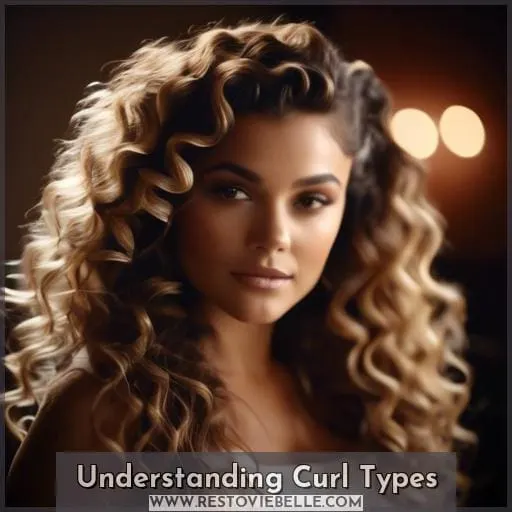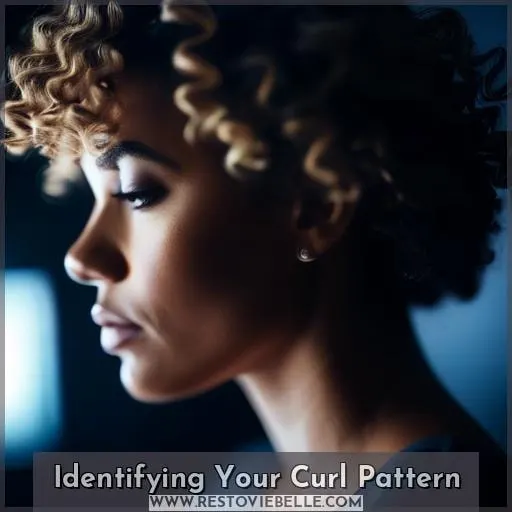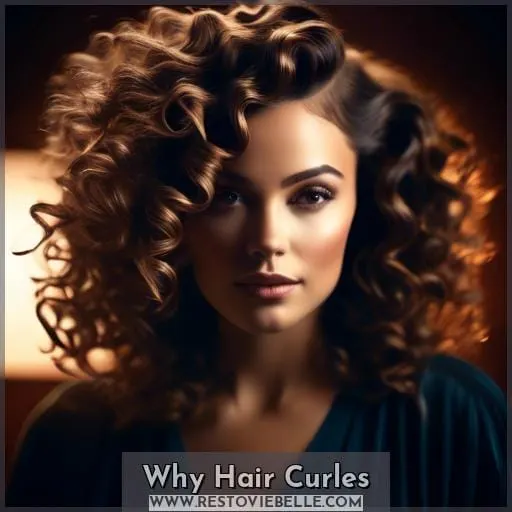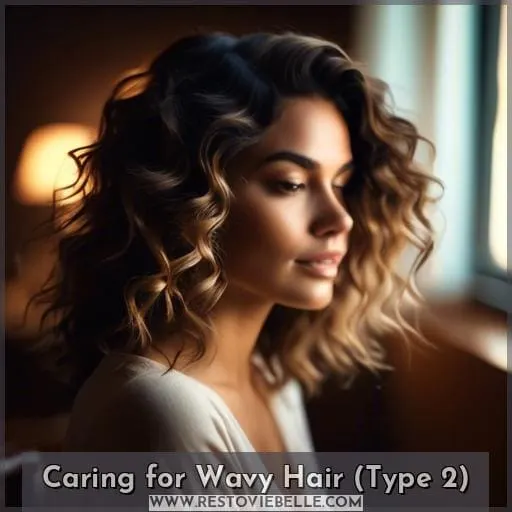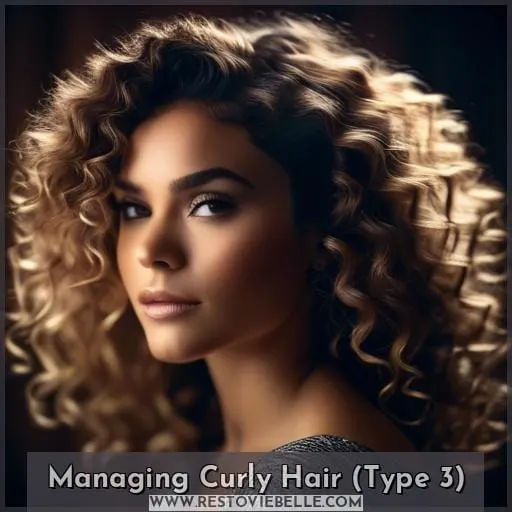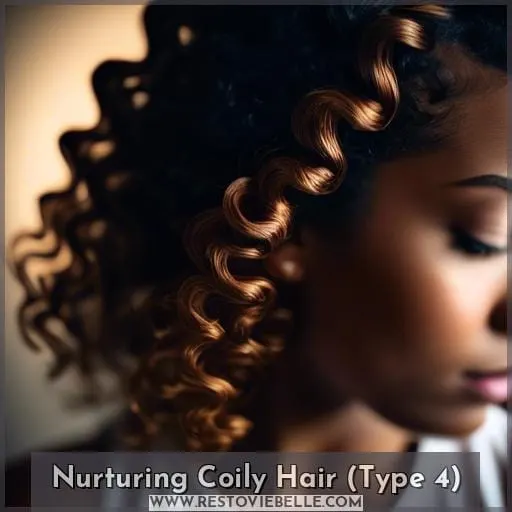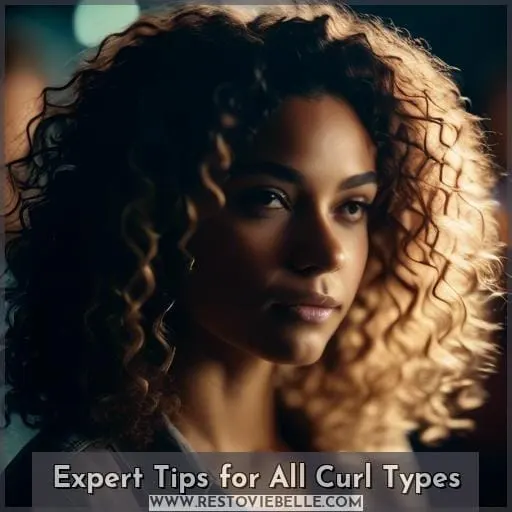This site is supported by our readers. We may earn a commission, at no cost to you, if you purchase through links.
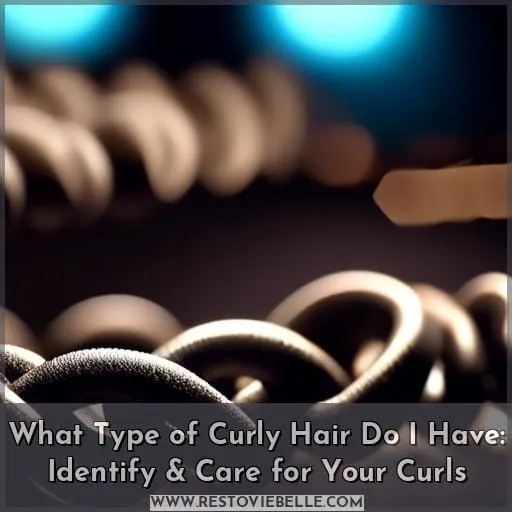 Discovering your unique curl type is the first step towards embracing and enhancing your natural beauty. Whether your locks form gentle waves or tight coils, understanding your specific pattern is key to unlocking the perfect care routine.
Discovering your unique curl type is the first step towards embracing and enhancing your natural beauty. Whether your locks form gentle waves or tight coils, understanding your specific pattern is key to unlocking the perfect care routine.
Curly hair, with its distinct spiral shape, varies in density and reacts uniquely to the environment, making it essential to identify your type for tailored care. Dive into the world of curls, from wavy Type 2 to coily Type 4, and learn how to nurture your hair’s natural texture.
Embrace this journey of self-discovery and mastery over your curls, and let’s find out: What type of curly hair do I have?
To determine what type of curly hair you have, you can refer to the curl typing system created by hairstylist Andre Walker, which categorizes hair into types 2 (wavy), 3 (curly), and 4 (coily), with subcategories A to C indicating the pattern size.
To identify your curl type, examine your hair when it’s wet, as this reveals your natural curl pattern without the influence of styling or products.
Table Of Contents
- Key Takeaways
- Understanding Curl Types
- Identifying Your Curl Pattern
- Why Hair Curles
- Caring for Wavy Hair (Type 2)
- Managing Curly Hair (Type 3)
- Nurturing Coily Hair (Type 4)
- Expert Tips for All Curl Types
- Frequently Asked Questions (FAQs)
- How can I determine the porosity of my curly hair and why is it important?
- What are the best techniques to trim curly hair to avoid the pyramid or triangle effect?
- Can diet or nutrition have an impact on the health and texture of my curly hair?
- How can I protect my curly hair from damage when swimming in chlorinated pools or saltwater?
- What are the most effective methods for transitioning from chemically straightened hair to naturally curly hair?
- Conclusion
Key Takeaways
Identify your curl type by examining the shape and pattern of your hair, ranging from wavy (Type 2) to coily (Type 4), with subcategories (A, B, C) indicating the tightness of the curl.
Choose hair care products and routines that cater to your specific curl type, focusing on moisture for all types but especially for tighter curls (Type 3 and Type 4) to prevent dryness and breakage.
Avoid harsh ingredients like sulfates and silicones that can strip natural oils from your hair, and seek out products that enhance and define your curls.
Consider your hair’s porosity and the effects of different styling techniques when customizing your hair care routine to maintain the health and appearance of your curls.
Understanding Curl Types
Understanding your curl type is key to finding the right hair care routine and products.
If your curls form loose S-shapes, you might have Type 2 wavy hair.
Tight ringlets indicate Type 3 curly hair.
For those with tight coils or kinks, you’re likely in the Type 4 category.
Type 2 (Wavy)
If you’re navigating the wavy waters of Type 2 hair, you’re in for a ride that’s as exhilarating as catching the perfect wave. This hair type, with its natural tousled texture and subtle curls, dances between straight and curly, offering a unique blend of versatility and charm.
Whether your waves are as fine as beach sand or as coarse as the ocean’s depths, understanding your specific curl pattern—be it 2A’s gentle ripples, 2B’s defined S-waves, or 2C’s bold bends—is key to unlocking your hair’s full potential.
Caring for wavy hair is like mastering the art of surfing; it requires balance, patience, and the right tools. Embrace lightweight wavy hair products that won’t weigh down your locks, allowing your natural wavy hair to shine.
Styling wavy hair is a creative journey—experiment with air-drying for a carefree look or use a diffuser to enhance your waves’ definition. And when it comes to volume, think of your hair as a wave ready to crest; flip your head upside down and tousle to add that extra oomph.
Type 3 (Curly)
A Spiral Adventure
Hey there, curl friend! If you’re on a quest to unlock the secrets of your spirals, you’ve stumbled upon the right spot. Type 3 hair is like the wild child of the curl family, boasting those springy, defined curls that can range from loose ringlets to tight, bouncy spirals.
Imagine your hair doing the twist and shout, with each strand dancing to its own beat.
Navigating the world of curly hair can feel like decoding a complex curl map, but fear not! Whether your curls are as big as a Sharpie marker or as tight as a pencil, there’s a world of styling options, product experimentation, and curl community wisdom waiting for you.
Dive into the curly universe with an open mind, ready to explore curl porosity, technique preference, and the endless array of products that promise to make your curls pop.
Type 4 (Coily/Kinky)
If you’re trying to figure out where your coily or kinky hair fits in the curl types, you’re delving into the world of Type 4 hair. This type is known for its tight curls and kinks, and it can be quite a journey to manage and maintain.
- Type 4A: Your curls have an S pattern and are tightly coiled with a visible curl pattern.
- Type 4B: Your hair bends with sharp angles, forming a Z pattern, and the curls are less defined.
- Type 4C: This type has the tightest curls of all, with a Z pattern that’s so tight that the curls may not be as visible.
Caring for your Type 4 hair means embracing growth challenges and making lifestyle adjustments. You’ll want to focus on keeping your hair moisturized, as it’s prone to dryness and breakage.
- Moisturizing: Look for products that provide intense moisture. Leave-in conditioners and deep conditioners are your friends.
- Protective Styling: Styles like twists, braids, and buns can help protect your hair from environmental damage and reduce manipulation.
- Gentle Detangling: Use your fingers or a wide-tooth comb to detangle gently, preferably when your hair is damp and conditioned.
Identifying Your Curl Pattern
Identifying your curl pattern is a crucial step in understanding how to care for your hair effectively. By examining your hair’s shape and texture, especially when wet, you can determine whether you fall into the 2A, 2B, 2C, 3A, 3B, 3C, 4A, 4B, or 4C categories.
2A, 2B, 2C
Diving into the world of Type 2 hair, you’re embarking on a journey of self-discovery that’s as thrilling as finding the perfect pair of jeans on the first try. Picture this: your hair, with its unique blend of waves, is like the ocean – sometimes calm, sometimes wild, but always beautiful.
Type 2A is your barely-there wave, like a whisper of the sea at dawn, fine and easy to style, craving lightweight products to dance freely without being weighed down. Moving on to Type 2B, imagine waves beginning to gather strength, with a more pronounced S-shape starting from mid-length.
This hair type is the rebel of the group, thicker and with a mind of its own, requiring a bit more effort to tame with texturizing mists. Then there’s Type 2C, the wild child, with thick strands that start their S-bend journey right from the roots, boldly embracing frizz as a sign of their untamable spirit.
For these waves, a non-lathering, sulfate-free co-wash is the secret potion for defining those luscious bends.
Navigating through the waves of Type 2 hair, you’ll learn the importance of curl porosity, striking the right moisture balance, and mastering volume enhancement without inviting the dreaded frizz. Each twist and turn of your hair’s texture, from the subtle hair waves of 2A to the more pronounced hair styling challenges of 2C, calls for a tailored approach with hair products that understand your hair’s unique language.
Whether it’s revitalizing those bends or simply letting your waves crash freely, embracing your Type 2 hair is all about celebrating its natural rhythm and flow.
3A, 3B, 3C
If you’re on a quest to unlock the secrets of your spirals, let’s dive into the world of Type 3 curls.
- Type 3A: Your curls are the social butterflies of the bunch, large and in charge, with a soft wave that’s ready to party around a sidewalk chalk-sized object. They’re prone to a bit of frizz, but nothing a little product can’t tame.
- Type 3B: These curls are the life of the curl party, with a spring in their step that’s tighter and more defined than their 3A pals. Think of a curl that can wrap around a marker or highlighter—bouncy and bold.
- Type 3C: The tightest of the trio, these corkscrew curls are packed with personality and as wide as a pencil. They’re the ones that bring the volume and the drama, making a statement that’s hard to ignore.
4A, 4B, 4C
Moving from the bouncy spirals of Type 3 hair, let’s dive into the world of Type 4 hair, where the curls tighten into a more complex pattern. If you’ve ever looked at your hair and thought, Wow, it’s like a tiny, intricate labyrinth, you’re likely in the Type 4 category.
This type is all about the kinks and coils that give your hair its unique personality.
Type 4A hair is like the secret handshake of the curl world; those in the know can spot those tight, springy coils a mile away. Imagine a series of tiny springs bouncing around your head, and you’ve got the 4A vibe.
It’s all about hydration for these curls, as they can easily dry out. So, think of your 4A curl care as being a bit like a plant mom—watering (moisturizing) is key.
Then there’s Type 4B hair, which takes a detour from the coily path and embarks on a zigzag adventure. Picture a series of sharp angles rather than rounded curves, giving your hair volume and texture that’s as unique as a fingerprint.
The 4B curl routine is like navigating a maze; it requires patience and a gentle touch to avoid breakage.
And finally, we arrive at Type 4C, the most tightly coiled of the bunch, with curls so close-knit they could keep secrets. This hair type experiences significant shrinkage, making it appear shorter than it actually is.
The 4C hair regimen is akin to being a master sculptor, carefully crafting and maintaining each coil with precision and care. Moisture is your best friend here, and protective styles are the secret to keeping those coils happy and healthy.
Whether you’re a 4A, 4B, or 4C, remember that your hair is a crown of curls, each with its own character and needs. Embrace the kinky hair tips and coily hair styling tricks that work for you, and watch as your hair thrives, turning heads and sparking conversations wherever you go.
Why Hair Curles
Understanding why your hair curls is like unraveling a mystery written in your DNA. As you’ve learned about the different types of curly hair, from the wavy Type 2 to the ultra curly Type 4, you might wonder what’s behind those twists and spirals.
- Genetics: Your curls are a family heirloom, passed down through generations. If your parents are part of the curly crowd, chances are you’ve inherited the trait.
- Hair Structure: Each strand of your hair is a complex structure, and the shape of the follicle—where your hair takes root—plays a big part. Round follicles tend to straighten things out, while oval ones throw a curveball, giving you those waves or ringlets.
- Moisture Retention: Curly hair is like a sponge for moisture, which can be both a blessing and a curse. It’s why a humid day can turn your hair into a frizz fest, as it soaks up the extra moisture in the air.
- Damage and Porosity: Your curls are sensitive souls. Damage from heat or harsh treatments can make them lose their bounce. And porosity—how well your hair holds onto moisture—can be the difference between a good curl day and a bad one.
Caring for Wavy Hair (Type 2)
Caring for your wavy Type 2 hair is like navigating a winding river – it’s all about going with the flow and adapting to the twists and turns. Your waves might play it coy, lying close to your head with a gentle S pattern, or they might get a bit bolder, with a more pronounced bend.
But no matter the type, they all share a common thirst for balance – not too much moisture, not too little.
Here’s a quick cheat sheet to keep your waves on point:
| Type 2A Hair | Type 2B Hair | Type 2C Hair |
|---|---|---|
| Fine texture that whispers of waves | A more defined S, starting to speak up mid-length | The boldest waves, shouting their S from the roots |
| Loves lightweight products that won’t weigh it down | Craves a texturizing mist to lift and define | Needs a sulfate-free co-wash to tame its frizz |
Managing Curly Hair (Type 3)
After exploring the waves of Type 2 hair, let’s dive into the springy world of Type 3 curls. If you’re blessed with this type of hair, you’re navigating a landscape of bouncy ringlets that can spiral into life with the right care.
But remember, your curls are like the weather—unpredictable and reactive to the environment. They can be as changeable as a chameleon, so it’s crucial to have a game plan for moisture management and frizz control.
Here are a few nuggets of wisdom to keep your curls in check:
- Moisture is your mane’s best friend: Regular hydration keeps those spirals supple and defined. Think of it as quenching your hair’s thirst.
- Frizz is the enemy: But it’s an enemy you can outsmart with the right arsenal of products, like a trusty hair co-wash or a leave-in conditioner that doesn’t weigh down your curls.
- Curl definition is the holy grail: Achieve it with products that love your hair type. Whether it’s a gel or a mousse, find your curl’s soulmate.
- Hair health is a journey, not a destination: Regular trims, deep conditioning, and avoiding harsh chemicals will keep your curls looking like they’ve just had a day at the spa.
Nurturing Coily Hair (Type 4)
Caring for your coily hair, also known as Type 4, is like nurturing a delicate garden; it requires patience, the right tools, and a whole lot of love. Imagine each strand as a spiral staircase, each step a potential snag in your detangling journey.
To avoid turning your hair care routine into a Herculean task, start by gently detangling coily hair with your fingers or a wide-tooth comb, working from the ends up to prevent breakage.
When it comes to styling coily hair, think of it as sculpting a masterpiece. You want to enhance its natural volume and shape without weighing it down. Lightweight products that don’t skimp on moisture are your best friends here. And remember, protecting coily hair from the elements is like sending your curls into battle with armor; use a good leave-in conditioner and consider protective styles to shield your hair from environmental stressors.
Nourishing coily hair is akin to feeding the soul. Deep conditioning treatments are like Sunday dinners for your hair, essential for keeping it strong and resilient. And when it comes to hair diameter, don’t let the fineness fool you; what your coils lack in width, they make up for in personality.
So, whether you’re considering hair weaves, wigs, or entrusting your precious locks to the hands of skilled hair stylists, remember that your coily hair is a crown to be worn with pride. It’s unique, it’s beautiful, and with the right care, it’ll have you turning heads wherever you go.
Expert Tips for All Curl Types
When it comes to managing your curls, selecting the right products and customizing your hair care routine are crucial steps.
You’ll want to consider your hair’s unique characteristics, such as its tendency to form a spiral shape and its varied density, as well as how it reacts to environmental factors.
By understanding these aspects of your hair, you can better maintain its health and appearance.
Product Selection
- Seek Moisture: Curly hair is like a sponge for moisture, so look for products that quench its thirst. Ingredients like shea butter and glycerin are your best pals for keeping those curls bouncy and happy.
- Avoid the Nasties: Dodge sulfates and silicones like you’d a rain cloud on a hair day. These ingredients can strip your hair of its natural oils or weigh down your curls, leading to a frizz fest.
- Embrace the Enhancers: Styling products like mousses or gels can be curl lifesavers. They help define your spirals and keep them in check, so you can rock your hair twists with confidence and style.
Routine Customization
Customizing your curl care routine is like being a chef in your own hair kitchen—mixing up a concoction that perfectly suits your unique curl pattern.
Think of your hair as a delicate fabric that needs just the right touch. Whether you’re a wavy wonder or a coily queen, the secret sauce to luscious locks lies in balancing moisture and choosing the right products.
Dive into the world of styling techniques that don’t just aim to tame but truly celebrate your curls. Remember, it’s not just about slathering on products; it’s about understanding the why behind each choice.
From the shower to the street, your routine should be as dynamic as your curls, ensuring each strand dances to the beat of its own drum. Keep your curls quenched, your frizz at bay, and let your hair’s natural beauty shine through with a routine that’s as unique as you are.
Frequently Asked Questions (FAQs)
How can I determine the porosity of my curly hair and why is it important?
To determine your curly hair’s porosity, try the water test:
Drop a clean hair strand into a glass of water.
If it floats, you’ve got low porosity; if it sinks slowly, medium; if it sinks immediately, high porosity.
Porosity matters because it dictates how your hair absorbs and retains moisture, influencing which products work best for you.
What are the best techniques to trim curly hair to avoid the pyramid or triangle effect?
To dodge the dreaded pyramid effect, embrace layers that frame your face and lighten the load on your crown.
Opt for a dry cut to sculpt curls precisely, avoiding thinning shears that can mess with your curl’s vibe.
Chat with your stylist about the shortest layers your mane can handle to keep things looking lush, not bushy.
Can diet or nutrition have an impact on the health and texture of my curly hair?
You are what you eat, and that goes for your curls too!
A balanced diet rich in protein, vitamins, and essential fatty acids can transform lackluster locks into bouncy, vibrant spirals.
How can I protect my curly hair from damage when swimming in chlorinated pools or saltwater?
To shield your curls from pool or ocean blues, saturate them with fresh water and a leave-in conditioner before diving in.
Post-swim, rinse thoroughly and treat with a deep conditioner to rehydrate.
What are the most effective methods for transitioning from chemically straightened hair to naturally curly hair?
Transitioning from chemically straightened to naturally curly hair is like navigating a dense forest; it’s a journey of discovery, filled with twists and turns.
The key is patience and embracing each curl as it emerges, akin to watching a flower bloom.
Start by ditching harsh chemicals and heat styling tools. Opt for gentle, moisturizing products tailored to curly hair, and consider protective styles to ease the transition.
Regular trims to gradually remove chemically treated ends will also help. Remember, this journey is unique to each individual, so embrace your natural texture and enjoy the exploration of your hair’s true identity.
Conclusion
Navigating the world of curls is like embarking on a voyage across the vast ocean of your hair’s potential.
By identifying what type of curly hair you have, you’ve set the sails towards a journey of tailored care and self-expression.
Whether your locks form gentle waves or tight coils, embracing your unique curl pattern unlocks the door to nurturing routines and products that resonate with your hair’s natural rhythm.
